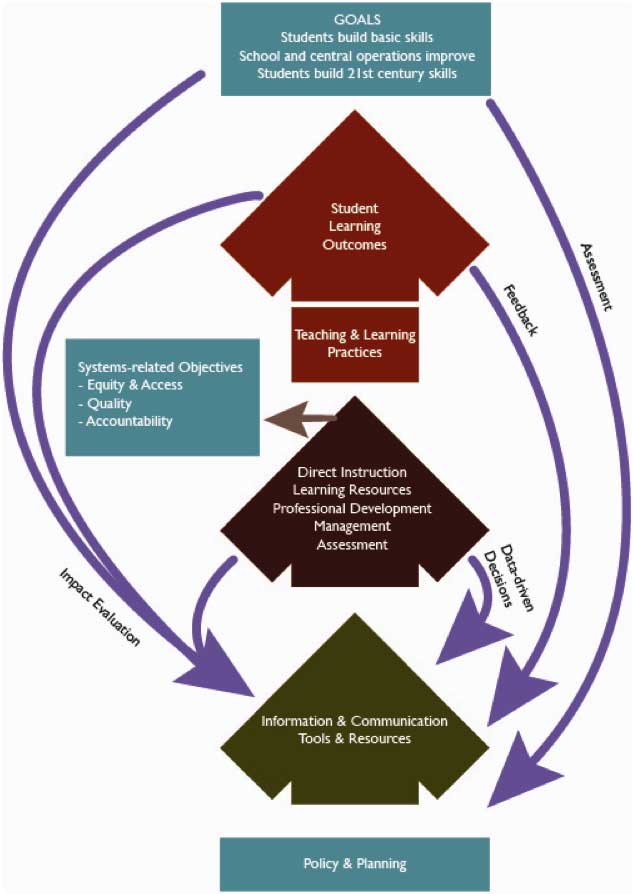 Tuesday, September 27, 2011 at 1:43AM
Tuesday, September 27, 2011 at 1:43AM Principle 1—Use ICT to achieve education and development goals
"Technology is a cross-cutting resource that should be seen as a sustainable, accessible, and valuable means of supporting efforts to improve teaching, learning, school operations, and the education sector as a whole. Projects using technology can entail risks that arise from costs, complexity, and resistance to change at many levels. To make such risks worth the reward, technology should be used to address areas where system capacity is poor, schools are underperforming, or there are gaps in student learning."
As mentioned, the bogey-man lurking behind this principle, and some of the others, is the IT curriculum—and more specifically the acquisition of computers and the funding of resources and the Internet to help kids learn how to use computers. It's incredibly inefficient and wasteful. In some countries, kids start taking basic IT classes in junior secondary school (or middle school) and continue through the end of senior secondary (or high) school. In a lot of instances, the kids don't build many usable skills, although they can identify a CPU, provide the definitino of a motherboard, and tell you how many bits are in a byte. And this requires six years of classes? Plus an exam?
To be fair, integrating the use of computer tools (e.g., laptops, desktops, tablets, smart phones, netbooks, etc) into other subjects is extremely difficult when the kids don't have basic mousing and keyboarding and file-management skills. But these can be learned in a two-week camp.
But "development goals" deserves a special call out. In poor countries, it's not unreasonable to consider ways in which education might contribute to social and economic development. Hence, "development goals" are something that can and should be considered in relation to the significant costs and risks of an ICT-supported project. Are the kids going to learn something that, eventually, ultimately, with many confounding factors that make evaluation challenging, will increase GDP? Or that will increase participation in government and civil society? Hmmmm?
(If not, perhaps the project should be reconsidered.)
What are some of the sub-principles undergirding Principle 1?:
Use ICT to support comprehensive change.
While education-technology projects often focus on single areas of activity, such as introducing digital learning resources, the cross-cutting quality of technology can enable comprehensive approaches that extend to many core components of the education system... information management and school leadership, teacher development, learning-resource distribution, and direct instruction.
The point, with this sub-core principle (so to speak) is that you are creating infrastructure, and that infrastructure can support change (and hopefully improvement) across the full spectrum of educational services. Primary-grade math-learning supported by multimedia? TVET for adult villagers? The same system, once it's in place, effectively maintained, and overseen by in-the-know leadership, can provide both.
Here's the idea, graphically:

Address areas of high need.
Given range of areas where technology can support improvement, projects can target specific factors or problems that have the potential to yield high impact or support further improvement...
Uh huh. Interactive Radio Instruction (IRI) is a wonderful tool, partly because it addresses a common problem in developing-country schools—teachers poor mastery of the subjects that they are assigned to teach.
Conceive of technology as “education infrastructure.”
Projects that establish the use of technology in schools—whether the tools used are radio, video, mobile phones, or computers—contribute to the strengthening of a school system’s education infrastructure.
OK, I wrote this sub-principle. But I still struggle to understand it. To my way of thinking, education infrastructure includes all the elements that contribute to a system's capacity. These can include, for example, a VPN linking schools (Indonesia), management skills for technology roll-outs (Syria, Pakistan), and a storehouse of digital content (Armenia, one hopes, and in the US, the excellent Hippocampus website offered by the Monterey Institute of Technology and Education [MITE]).

